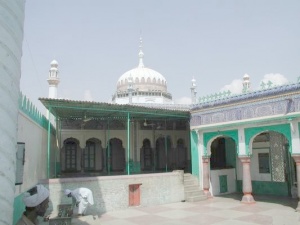Guru Nanak & Shamsis
Article by (Lucky 17:55, 15 July 2009 (UTC)).....under construction
Guru Nanak Sahib met Shamsis in multan in 1530 and had discourse with them and bring them into right track. Guru sahib have discourse with Bahawal Haq and Rukn din. His message was to become followers of god then grave, against anal-haq.
Who were Shamsis?
Shamsis are followers of Shamas Tabrez. Shamas Tabrez was a sufi faqir. his real name was Makhdoom Shah Shamas-Ud-Din. He was born on 17th rajab 560th hijri in Shabzawar(in Ghazini). He preached his religious philosphy and went to Multan the center of orthodox Muslims. his slogan of anal-haq(I am God) was not liked by them. They declared him a rebel and complained higher authorities. He was given death punishment. Shamas accepted the punishment with smile and he was killed mercilessly by removing his skin.
In multan a mausaleum was made in his remembrance by his followers who were known as shamsis. Shamas was god follower(Khuda - parasat), but Shamsis were becoming followers of grave as the time passed.
What's Anal - Haq
Sufi Faqirs shouting in ecstasy 'Anal-Haq, Anal-Haq' (I am the god/I am the Truth).Mansur Al-Hallaj was a famous Sufi of the 10th Century. He was executed in 922 AD for having stated: "Anal Haq" which means "I am the Truth". He was condemned to hang by the neck for shouting in ecstasy 'Anal-Haq, Anal-Haq' (I am the Truth, I am the Truth). The orthodoxy understood this to mean that he was claiming to be God himself, whereas he had proclaimed in his sublime spiritual ecstasy, simply a total annihilation of himself. What he meant was that he mattered naught; all that mattered was He (God)
Philosphy of sikhism is opposite to analhaq, it says mera mujh mei kuch nahi jo kuch hai sabh tera. it's toon toon.
What's KabarPrasat
Shamsis became follower of grave. They started keeping Rozas which was opposite to sikhism philosphy and philosphy of shamas tabrez too. Sikhism says "kou butan ko pujar hai pas, kou mritan ko poojan dhayo, koor kriya urjheo jagg mei sri bhagwan ka bhed na payo"
Guru Nanak Discourse with Shamsis
In 1530(acc to Prof Sahib Singh) Guru Nanak went there and sat in a garden around shamas maqbara's. When peers came to nknow this, they went and met guru. They kept milk before them and said that their path is pure as white as the milk without any blot. Guru Nanak sahib plucked a jasmine flower and kept it on milk and replied that one have to think and live above maya like jasmine flower is floating over milk. they taught them not to follow grave. tyhey also said that once ganga merges to ocean it's no ganga anymore and so one should not say i am god if he or she reached in that state.
Bhai Gurdas in his vaars said:
- Pauri 44.5 Melio baba uthia Multane di jarati jai.
- Pauri 44.6 Agon pir Multan de dudhi katora bhari lai ai.
- Pauri 44.7 Babe kadhi kari bagal te chambeli dudhi vichi milai.
- Pauri 44.8 Jiu sagar vichi Gang samai.
Leaving the fair at Achal Vatala Baba went on a 'pilgrimage' to Multan. At Multan the Pirs came forward holding a bowl of milk full to the brim. Baba took out a jasmine flower from his bag and put it on the surface of the milk indicating that he would spread fragrance. Bhai Gurdas likened it to the river Ganga merging into the ocean.
Debate
Bahawal Haq and Rukan Din asked their questions, Bahawal said, We call money false and without money we cant survive, guru sahib replied like money is false so living is also false.
Peers want guru sahib to do a updesh " gurtu ji said Love Everyone, Dont go with other's woman, The matter which generates fight with saints close it immideatly. Dont accompany evil minded person. Do Selfless service of saints. Practice Shabad
Peers were enlightened and for remambrance they took foot prints of guru on page. It is said that page was at multan upto partition of 1947.
References
- Bhai Bala Janamsakhi
- Bhai Gurdass Vaar
- History of Guru Nanak: Prof Sahib Singh

